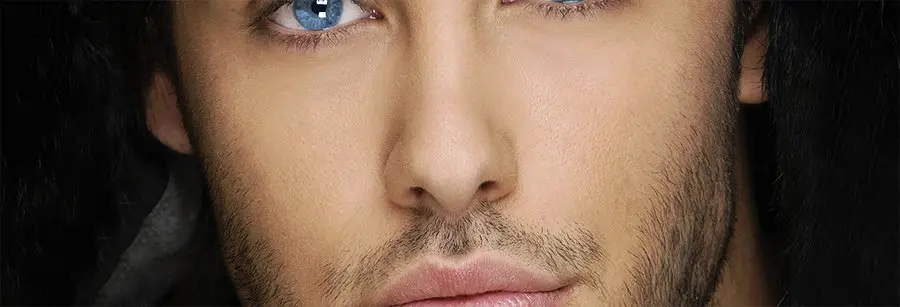
Noses are the cornerstone of the field of facial aesthetics, and while humans go from daylight to dark looking at our own noses out of the corner of our eyes, we rarely notice them. However, throughout history, the human nose has been a powerful cultural icon with multiple connotations and standards of beauty around the world. So what is the ideal nose shape?
There are many different kinds of nose shapes throughout the world – from aquiline noses to Roman noses that are considered attractive. According to facial aesthetics, the ideal nose shape should be in proportional symmetry with the rest of the features of the face, especially the eyes and mouth.
Nose shapes vary widely by ethnicity and geographical background. Read on to learn more about the various nose shapes that you might run across and how they hold up to standards of facial aesthetics.
For a quick overview of important nose aesthetics principles, check out this Looks Theory episode:
Nasal Surgery Throughout Human History
While most people probably associate cosmetic surgery and nose jobs with modern medical science, the truth is that rhinoplasty (or corrective nose surgery) has been around for thousands of years.
Dating back to the ancient Egyptians, physicians have performed surgeries both to try to reconstruct facial trauma as the result of nose damage or loss, as well as facial surgeries to improve the overall appearance of the nose in the upper class. The oldest medical treatise that refers to nasal corrective surgery in the ancient world is a treatise by the Egyptian physician Imhotep called the Edwin Smith Papyrus.
Because they are soft and cartilaginous, noses are also one of the most easily damaged structures in the human face from the result of blunt force trauma. From warfare to bloodsports to fisticuffs at the local tavern, broken noses are a mainstay of common human injuries. This led to an interest in the reconstruction of damaged or displeasing nasal appearances early on in human history.
Since a rhinotomy (or nasal amputation) is considered extremely disfiguring, the practice of nasal reconstruction in medieval medicine cropped up to combat this problem. In India, this led to the adoption of a nasal reconstructive surgery designed by the surgeon Susruta (known as the father of modern surgery) that reconstructed an amputated nose through the use of a flap of forehead skin.
Unfortunately, this kind of cosmetic surgery was deemed immoral by the church of the day, and it was primarily blackballed and historically forgotten until its reemergence in the late 1700s when it was reintroduced to Europe through a magazine article summarizing and explaining Susrata’s Indian nasal reconstructive methods.
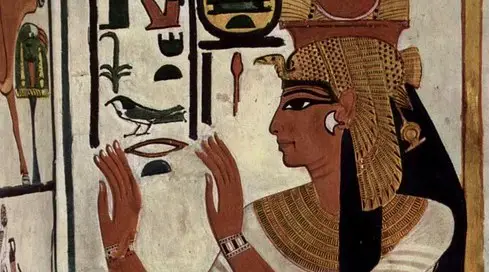
Nose Shape and Evolution
So, why do people have so many different shapes of noses? The main reason for varying nose shapes comes back to human evolution in response to different climates. Studies have shown that those people who have a facial structure that conforms with colder climates, such as Nordic peoples, tend to have longer and narrower nasal passages than those who hail from hot, humid climates.
As air is passed through the nasal passage, it is warmed by the interior of the nasal cavity. The longer a person’s nose is, the warmer the air is by the time it reaches their respiratory tract and lungs, and the more exposure this air has to the bacteria and detritus-trapping hairs of the nasal passage. In turn, these longer noses in cold climates help prevent cold-weather peoples from succumbing to climate-related diseases.
In warmer climates, having wide nostrils and a shorter, broader nose bridge helps to keep air cool as it enters the respiratory tract, which in turn helps to reduce metabolic pressure to maintain cool body temperature in scorching environments.
The ethnic shape of noses as they vary by region is as much determined by climate and environment as it is by other factors such as genetic drift and sexual selection, which is why the phenotypes for noses across the world vary so widely. As a result, even though there is a golden proportion that is deemed conventionally attractive according to modern aesthetics, personal preference for nose type varies across the planet.
Leptorrhine noses are common in Caucasians. Mesorrhine noses are common in Asians. And Platyrrhine nose is common in Africans. The biggest difference between them all lies in the nasal index, which we will discuss.



Anatomy of the Nose
There are many different parts of the nose since it extends outwards from the face, making it one of the most prominent and dominating facial features. Here are some of the features of nasal anatomy:
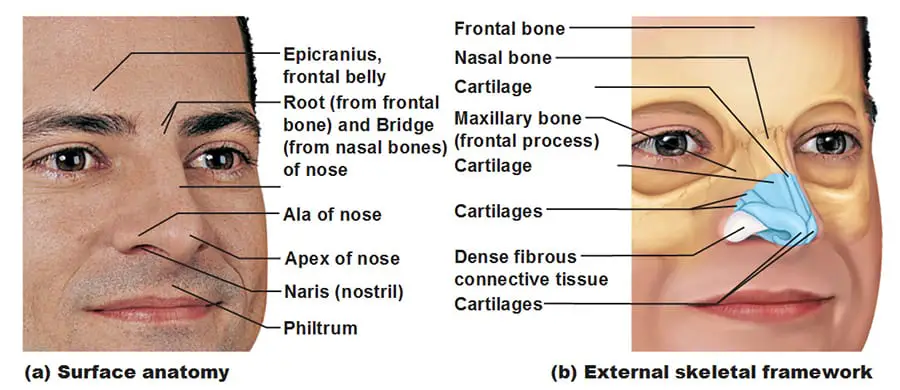
- External nose and nasal cavity: The main structure of the nose consists of the exterior of the nose (covered by skin and cartilage) and the interior nasal cavity, which is primarily constructed from mucous membranes and sinus tissue.
- Bony and cartilaginous framework: Unlike most parts of the face, which are constructed from muscle and bone, the protrusion of the nose is a combination of the bone framework in the upper third of the nasal column and cartilage in the lower two-thirds of the nose.
- Root, tip, apex: The root of the nose is the part of the nasal structure where the bridge of the nose meets the forehead (between the eyes). The tip is the furthest point of the nose away from the planes of the face, and this part of the nose is also known as the apex.
- External nares (nostrils): The nostrils are the rounded protrusions at the bottom of the nasal structure that permit open access to the nasal and sinus cavity, leading back into the respiratory system. The nostrils are responsible for the uptake of air, sense of smell, sense of taste, and defense of the immune system in the form of detritus-trapping hairs in the nasal passage.
- Nasal septum and columella: The nasal septum is the strip of tissue that separates the two separate columns of the nares, and the columella is the very furthest margin of the nasal septum tissue where it meets the base of the nose. The septum is the main support structure of the interior of the nasal cavity.
- Nasal dorsum: The nasal dorsum is the bony structure that makes up the bridge of the nasal structure and is responsible for the overall profile of the nasal shape. The nasal dorsum is one of the main structures affected during rhinoplasty in many cases since the nasal dorsum is the part of the nose that is most likely to impact the overall appearance of the face negatively.
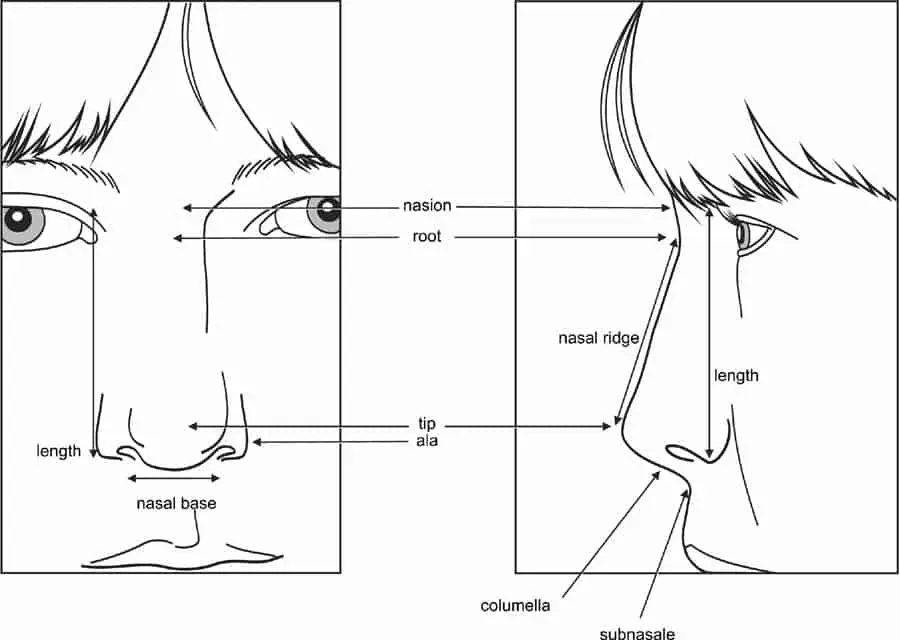
The nose is a complicated structure in the face, which means that many different methods can alter it to increase its value to overall facial aesthetics. Because it is such a prominent facial feature, a disproportionate or crooked nasal structure can throw off the look of the entire face. This is especially true of a nose that has been damaged by blunt trauma.
Along with its effect on physical appearance, the nose also plays a significant role in several other bodily functions, including respiration and the human sense of smell and taste. Even though the human nose is nowhere as sensitive as many other mammals, it remains a major part of our working anatomy and contributes to how we perceive the world in a big way.
Facial Proportions That Affect Nasal Aesthetics
Other than the shape of the nose itself, there are various aspects of nasal structure within the context of the face’s proportions that affect how the nose is viewed as part of the overall facial structure/aesthetics.
Here are some of the various facial proportions that have an effect on nasal aesthetics and how they are perceived by onlookers:
Vertical Proportions
The neoclassical aesthetic proportions of the human face are divided into fifths vertically. The width of each eye and the nasal width are also measured to a fifth proportion. This means in the ideal facial shape, the width of the nostrils should be no broader nor narrower than the width of the eyes to achieve aesthetic symmetry.
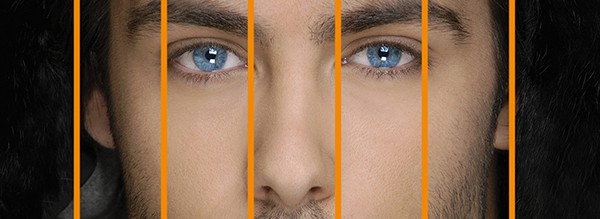
Transverse Proportions
As opposed to vertical proportions, transverse proportions (facial thirds) break the face into equal proportions horizontally. Along with vertical proportions, transverse proportions are used to determine the “golden proportion” as it pertains to facial aesthetics.
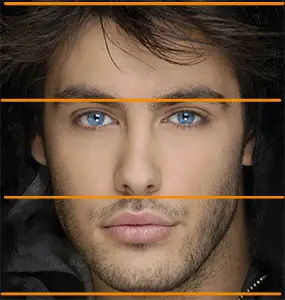
Symmetry
Regardless of a person’s nose shape, the symmetry of their overall face—including the symmetry of their nose—plays a large part in their overall perceived attractiveness. This often leads those with asymmetrical nasal features to seek cosmetic correct to rectify this asymmetry for overall improved facial aesthetics.

Nasal Index
In nasal aesthetics, the nasal index consists of the ratio of the breadth of the nose to the length of the nose. This ratio varies widely between different ethnic groups per the climates associated with their geographical locations. For example, ethnicities that originate from arid climates tend to have more narrow noses, while those from humid climates have broader noses.
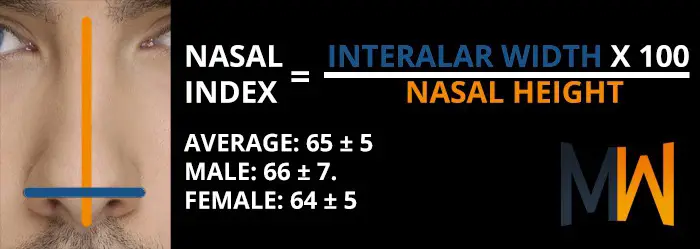
Nasal Tip Morphology/Projection
The nasal tip consists of the juncture between the nasal bridge and the columella. The easiest way to recognize the nasal tip is to recognize it as the part of the nose that is furthest from the planes of the face. Nasal tip projection consists of the perpendicular line between the vertical facial plane and the anterior projection of the nasal tip.
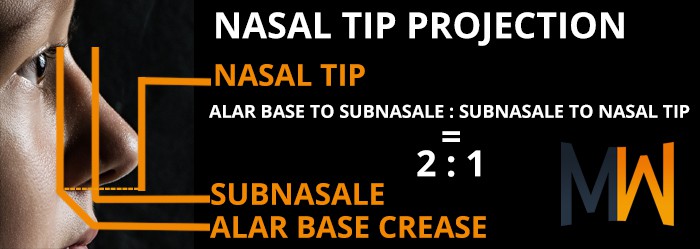
Columella-Alar Relationship
The relationship between the columella and the alar (the cartilage of the nasal cavity) is one of the most critical aesthetic relationships in the lower one-third of the nose. The types of defects present in the columella-alar relationship that negatively affect nasal aesthetics in facial proportion are a hanging columella, a retracted alar, or a combination of these two aspects.
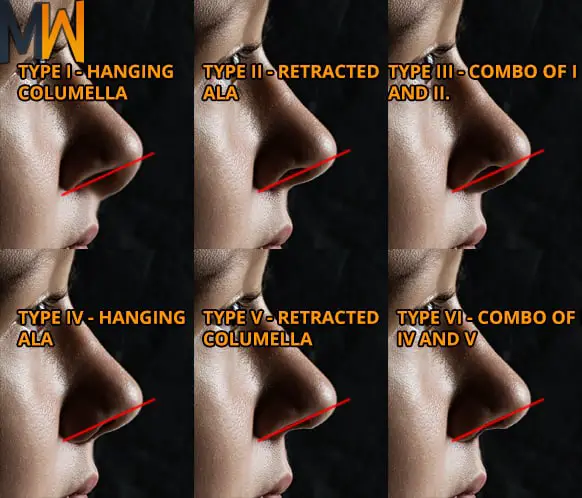
Nasion Position
The nasion is the part of the nose that is the most anterior section of the frontonasal suture between the frontal bone and the nasal bones of the upper nose structure. In laymen’s terms, the nasion position is the bump between where the bridge of the nose meets between the eyes and contours into the brow ridge. Unfortunately, discerning the nasion position is difficult without an X-Ray. But ideally, it should be 2 mm. below the eyebrow line and 5 mm. above the intercanthal line.
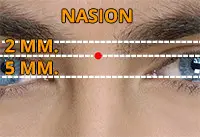
Radix
The radix is the part of the nasal structure located directly beneath the nasion where the bridge of the nose meets with the vertical planes of the face. The location and prominence of the radix per nasal and nasion positioning has an important impact on the overall proportions of the face. A reduced radix or a prominent brow ridge can make the nose appear more prominent than it really is. Sometimes implants are inserted into the radix to balance out the nose.

Nasolabial Angle
The nasolabial angle is the angle created by the philtrum and the columella. This angle differs greatly between men and women and is important for sexual dimorphism. A woman’s ideal nasolabial angle is 105 degrees and a man’s is 97 degrees, according to Sinno et al. (2014).
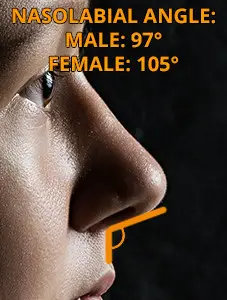
Nasofrontal Angle
In facial aesthetics, the nasofrontal angle is the angle created between the vertical line of the face and a line that begins at the nasion position, extends down across the radix, and then down the bridge of the nose itself. This angle determines how far out the nose sticks out from the planes of the face, and often whether a nose is perceived as large or small. The sharper the nasofrontal angle, the more prominent a person’s nasal type.
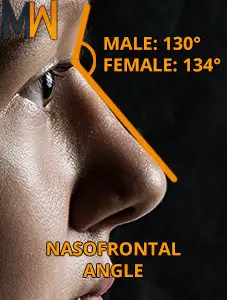
Nasofacial Angle
The nasofacial angle is the angle of the nasal structure as it pertains to the perpendicular line of a person’s facial plane. The perpendicular line of a nasofacial angle is measured from the ridge of the brow down, while the second half of the angle is formed by the bridge of the nose.
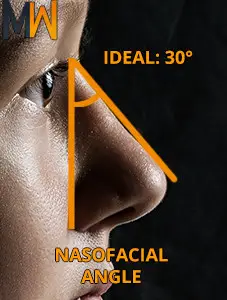
Nasal Height to Projection Ratio
The nasal height to projection ratio refers to how nasal proportion fits into the golden proportions of the face that affect overall facial aesthetics. If the nasal height is disproportionate to the other aspects of the face, this throws all facial aesthetics out of whack. The length of the line from the sub-nasale to the nasion should be in a ratio of 2.8:1 with a line perpendicular to it that goes to the nasal tip.

Nasal Tip Angle
The nasal tip angle is the angle of the nose from the tip of the nose to the base of the nose along the line of the columella and alar. The nasal tip angle determines whether a nose is perceived as upturned or downturned, and can lead to the appearance of either a celestial/snub nose or a hooked nasal appearance (Roman, hawk).
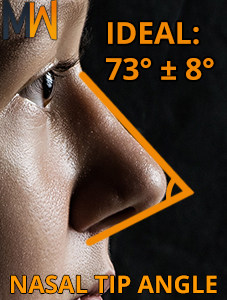
Nasal Forehead/Brow Ridge Relationship
The prominence of a person’s brow ridge in their facial structure can hurt the appearance of their radix and nasion, causing these areas of the nasal structure to appear depressed in relation to the brow. Prominent brow ridges are associated with testosterone and masculinity, and as a result, women may have their nasal forehead and brow ridge surgically corrected to diminish this aspect.
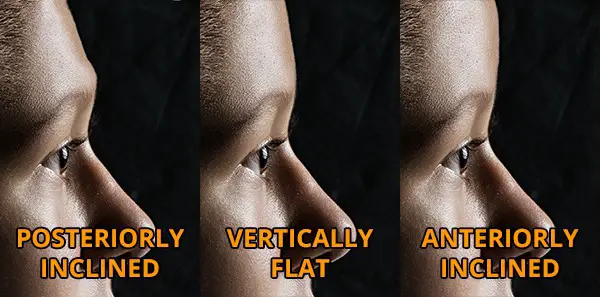
Nasal-Upper Lip Relationship
The area between the base of the nose and the upper lip is known as the philtrum, and is also known as the medial cleft. In some cases, the philtrum is shortened in cosmetic surgery to correct the proportions between the nose and the bottom third of the face. If the upper lip is retrusive, then the projection of the nose appears increased.
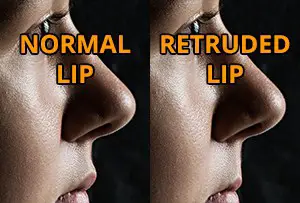
Nose Characteristics and Shapes
The main factor that determines the attractiveness of a person’s nose is how well it fits in with the rest of their face. There are many types of “imperfect” noses that can be found in men and women. Not only are these different nose types one of the things that set apart different types of faces, but these nose types have also historically been associated with different human personality traits.
Classifying noses into distinct “shapes” and “types” is largely a subjective pseudoscience. However, there are still trends and things that we can learn from by analyzing these shapes, and plastic surgeons refer to these shapes as well.
Here are some of the different nose shapes and characteristics that are commonly seen in human faces. Keep in mind that these nose shapes are also not mutually exclusive. For example, you can have both a snub and an upturned nose.
The Duchess
The most popular nose shape requested in rhinoplasty is the Duchess—named after the near-perfect nose of the Duchess of Cambridge. It’s a straight nose with an obvious bridge, a 106-degree nasolabial angle, and harmonious width and height. Unlike the upturned nose which is also highly requested by women, this nose type also looks good on men.
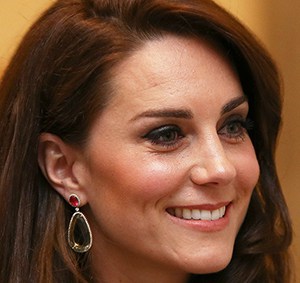
Bulbous Nose
A bulbous nose is basically just a nose that is extremely wide and thick. Because it’s so massive, it lacks definition. It’s more common in men because of their thicker skin.
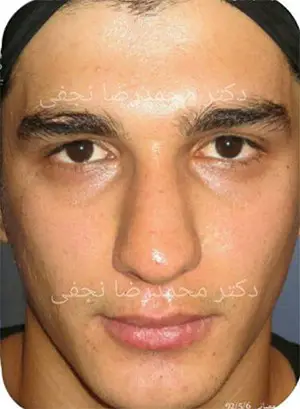
Fleshy Nose
People with a fleshy nose have a narrow nasal root that expands out into a bulbous apex and tip. Fleshy shaped noses are the most common nose shape, with more than 24% of people born with a fleshy nose. Fleshy noses can be either large or small but are identified by the fleshy or fatty appearance of the nasal tip, rather than a bony appearance.

Turned-up (Upturned) Nose
A turned-up nose (also known as a “celestial nose” or “upturned nose”) is a smaller nasal type with a bump in the bridge that leads to the apex to be tipped upward. This is a nose type that is commonly seen on female celebrities and is one of the most popular nasal shapes that is desired in rhinoplasty.
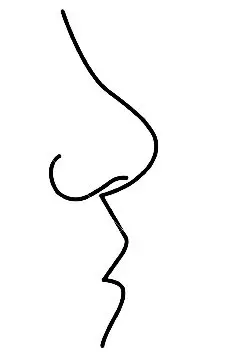

Roman Nose (Aquiline Nose)
The Roman nose is so named because it is most commonly associated with the facial features of ancient Roman statues. The Roman nose consists of a nasal bridge that is long and well-defined with a slight sloping curve. This type of nose gives the face a strong, masculine profile and is a popular nasal type among male celebrities. The Roman nose is also known as an aquiline nose.
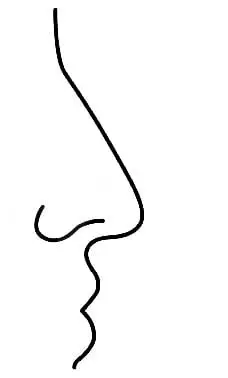
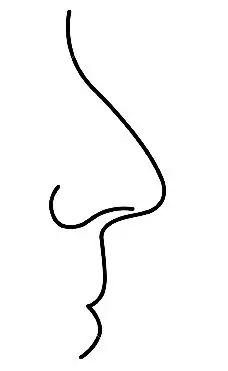
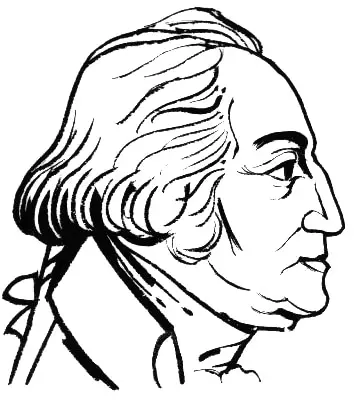
Bumpy Nose
Noses that have bumps along the nasal bridge (either as the result of natural shape or as the result of trauma) are a common nasal type, appearing in approximately nine percent of the population. Bumpy noses usually feature a curved tip that is either subtle or pronounced. Many individuals with bumpy noses seek out a rhinoplasty to improve this feature.
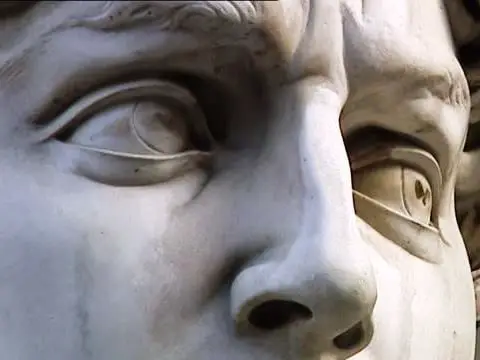
Snub Nose
A snub nose is similar to a celestial nose in that it features a smaller profile and thin bone structure, but features a softer, rounder appearance than the turned-up nose. Snub noses are considered one of the more attractive nasal types to have, although the nose shape only naturally occurs in 4.5% of the population. Snub noses are associated with upper-class refinement since it is a nose shape that is popularly sought by cosmetic surgery.
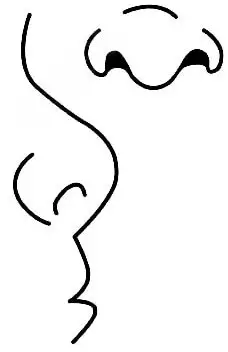
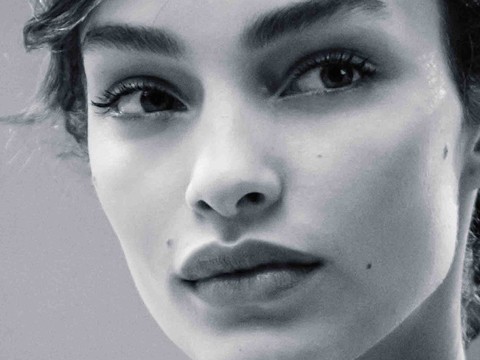
Hawk Nose
A hawk nose is one of the more prominent nasal types encountered, and this nose shape is also known as a “hook nose” or “eagle nose.” Hawk noses are marked out by a distinctive curve in the bridge of the nose and sharp contours that give the nose the impression of an avian beak. Large hawk nose shapes have been popularized by movie stars such as Barbara Streisand and Adrien Brody, and are associated with a maverick personality.

Button Nose
A button nose is small, flat, and round. It looks best on women, especially with a ski-slope curvature.
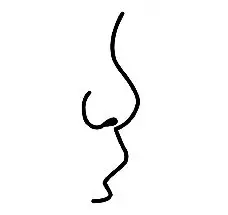
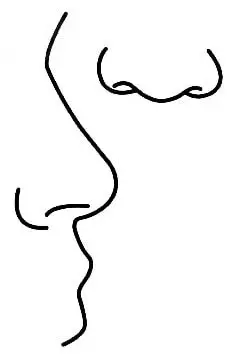
Greek Nose
The Greek nose shape is similar to the aquiline nose shape and is determined by a long, narrow, straight nose bridge. Like Roman nose shapes, Greek nose shapes are most commonly associated with the noses seen in ancient Greek statues. Greek nose shapes are one of the more uncommon noses, with only three percent of the population naturally having one.
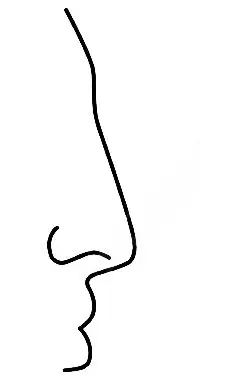
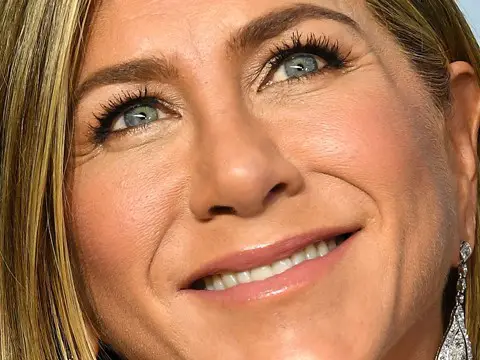
Nubian Nose
A Nubian nose is distinguished by a width that is broader or equally broad as the length of the nose, leading to a widened nose shape with large nares. Nubian nose shapes are associated with individuals of African descent, and those with overly broad Nubian noses often seek out a rhinoplasty to narrow their nasal bridge and nostrils.

East Asian Nose
East Asian nose shapes tend to sit short and shallow on the face, with a dropping nasal septum and a fleshy tip. Like the Nubian nose, East Asian noses are often undefined in comparison with European nasal types and have a gently sloping bridge and wide nostrils.

Nixon Nose
The Nixon nasal type (named after the iconic president) is a very rare nose shape, with less than one percent of the population possessing it. The Nixon nose shape is defined by an extremely long, straight, narrow bridge terminating in a bulbous, fleshy tip, and wide-set nostrils.

Droopy Nose (Droopy Nasal Strip)
Drooping nasal strips and tips are the results of aging, broken-down cartilage in the nasal structure or too much cartilage in the nasal structure. A droopy nasal strip is one of the nose shapes that is often corrected through plastic surgery in those who are unhappy with it as a facial feature.

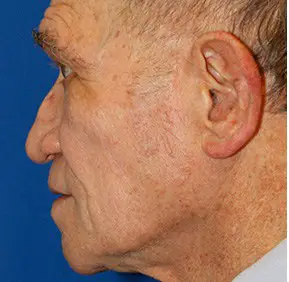
Ideal nose shape varies from culture to culture, but the more popular culture becomes a worldwide phenomenon, the more celebrity noses on beautiful people are admired and emulated by the general population. This has led to an uptick of cosmetic rhinoplasty related to correcting the nasal shape, rather than just reconstructing nasal trauma.
Along with helping to create distinction and individuality in the human face, the wide variety of nasal shapes found in human populations are also associated with a wide variety of personality traits. The art of determining a person’s personality by their facial structure is called physiognomy. For example:
- Those with snub noses are associated with aristocratic or snobbish behavior
- Those with Greek noses are associated with intellectualism.
- Those with hawk noses are associated with individuality.
While these personality traits do not hold true for all nasal types, there is enough grain of truth to the practice of judging a person by their nose and facial structure that it has persisted for thousands of years despite being largely debunked in the 19th century as real science.
The degree to which one nasal shape can be shaped into a different nasal shape is determined by the underlying bone and cartilage structure of a person’s nose. Large noses are challenging to change into tiny noses, and vice-versa. For the most part, cosmetic surgeons have to work within the confines of a person’s facial structure and come up with a nasal shape that compliments them.

Nose Shape is a Fundamental Cornerstone of Facial Aesthetics
The nose is oriented squarely in the center of a person’s face, which means that its distance and relationship to all other parts of the face is a cornerstone of facial aesthetics. Without an adequately proportioned nose, the appearance of the entire face becomes aesthetically displeasing from a conventional perspective.
Because the nose is such a complicated structure on the face and has such an important role to play in facial proportions, facial reconstruction surgeons and cosmetic surgeons pay very close attention to how these different planes of the face interact with each other to form an aesthetically pleasing whole.
One of the major reasons cosmetic rhinoplasties are so popular is because the shape of a person’s nose has a profound effect not just on their self-esteem and how they see themselves, but also on how they are culturally perceived by others. There are thousands of years of cultural conditioning tied into how the shape of a person’s nose is perceived.
Through the use of increasingly sophisticated surgical techniques and materials, plastic surgeons can tweak a person’s nasal proportions until the perception of their face can be radically altered by just a few simple alterations in shape, size, or contour.
Many people may believe that beauty is only skin deep or that it rests in the eye of the beholder, but others will tell you that it starts with a perfect nose.

